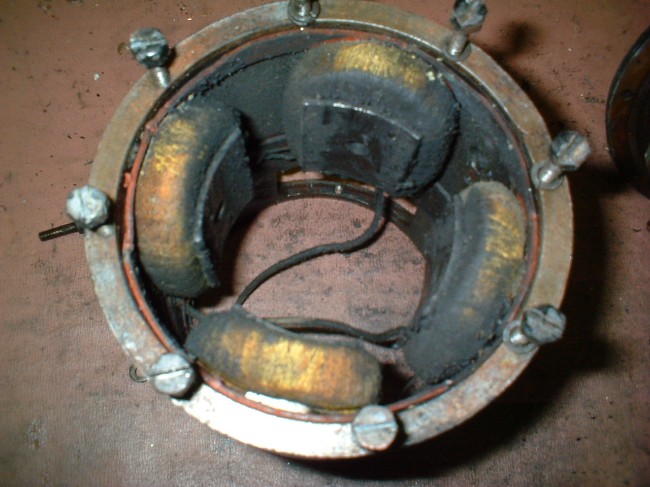Translate This Page
Field Coils - Are yours re-usable?
How to test them
Do you need new coils?
Field coils are hidden away inside the dynamo.
Some dynamos have one coil, most have two and some have four coils. The coils shown below are new.
The metal "shoes" below in the picture hold them in place and are fixed with either 1 or 2 screws.
The coils in the picture below are in a Lucas dynamo and are contaminated with oil.
The insulating cloth tape is soft and rotten.
Fit only for the scrap bin!
The coils in this next picture are also contaminated.with oil and the insulation has gone brittle with age. This also happens when a dynamo has over heated and "cooked" itself due to being heavily overloaded or the mechanical cut out has stuck closed.
Once again - Scrap!

Over the years the varnish and/or cloth tape insulation can deteriorate causing burning and eventual shorting.
3 brush dynamos have field coils of very low resistance which is a requirement of the primitive 3rd brush system of regulation. To create an efficient 2 brush machine the resistance needs to be higher or the machine will work VERY inefficiently so we wind new coils to suit either 6 or 12v conversions.
Some pre-war 2 brush dynamos have coils of acceptable resistance that allow it to be connected to an electronic regulator without modification however it is advisable to let us check for burning, shorting or dried out and rotted cloth insulation if the dynamo is to be used and be efficient at the same time. We can re-tape and re-varnish coils that are found to be in serviceable condition otherwise.
For most of the later post war Lucas C39, C40 C42 and C45 dynamos we can supply new field coils off the shelf if needed.
TESTING FIELD COIL RESISTANCE
You can test the field coil resistance of your dynamo quite easily if you feel competent and have access to a multimeter with a resistance range on it.
Do not run the engine for these tests.
For 2 brush dynamos it's easy - Dis-connect the 2 wires F&D from the dynamo. Set your meter to its 20 or 200 ohms scale.
So, with your meter set, touch the 2 test probes together and note the reading.
In the example above the resistance of the meter leads is 0.7 ohms. Note down the resistance of your meter leads. Next touch one probe on the F terminal on the dynamo and the other to a good earth point on or very near to the dynamo. The reading on the meter after deducting the resistance of your leads is the resistance of the field coils. So, for example - A Lucas C45 YV 12v 2 brush dynamo will show a reading of around 6.9 ohms on the meter in the picture above. Deduct the 0.7 ohms lead resistance and you get 6.2 ohms.
This is correct for this particular dynamo.
The equivalent 6v C45 YV should be 2.9 ohms
after deduction. Both these figures are good.
Check the inside of the dynamo to see if it is
contaminated with oil. There's a good chance that
the field coil cloth insullation is rotten if oil
contamination is present.
3 brush dynamos are a little harder to test. First you need to identify the 3rd brush. This is the smallest of the 3 brushes in the dynamo. Lift the 3rd brush under its spring pressure and slide a thin piece of card between it and the commutator that it rubs on. Next, touch one probe on the F2 terminal on the dynamo and the other probe on the wire that connects to the 3rd brush. The figure after deduction (as above) is the field coil resistance.
For example, a 6v Lucas C35A BN dynamo as fitted to some Austin Sevens when tested on the above meter will show a field resistance of around 1.6 ohms.
A 12v C45A will show a reading of around 2.5 ohms.
Both these figures are too low to make an efficient 2 brush 6 or 12v dynamo. Again if oil contamination is present then the coils are best scrapped anyway.
In both these instances we would wind new coils to an ideal resistance for both a 2 brush conversion and also to suit a hidden electronic regulator. We would also fit new fixing screws if the originals are not fit for service.
There is sometimes an exception to the 3rd brush rule and that is when the field coils are connected in parallel (shunt) instead of in series. This was the case in very few 3 brush dynamos.
If in doubt, send me your dynamo and I will do the tests for you and advise you accordingly. I will never replace coils that are good and fit for further use but it is not worth cutting corners here to save a few pounds.